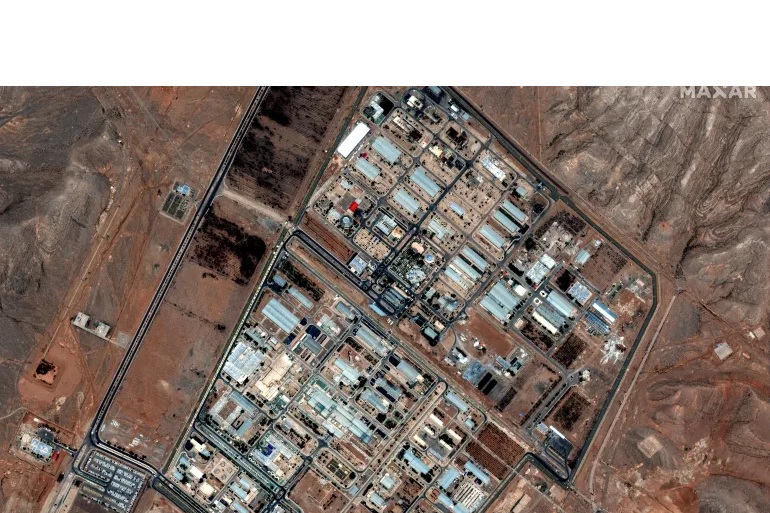Tensions between Israel and Iran escalated dramatically over the weekend as Israeli forces launched another wave of airstrikes, targeting a sensitive nuclear facility in Iran’s Isfahan province.
Iranian officials confirmed that the strike hit a nuclear site near the city of Isfahan in the early hours of Saturday, June 21, 2025, prompting air defenses to activate.
While smoke was seen rising from a mountainous area near the facility, authorities emphasized there were no radiation leaks and no casualties reported at the site.
This marked the second Israeli attack on Isfahan since hostilities began and comes amid intensifying conflict between the two regional adversaries.
Iran’s health ministry reported that at least 430 people have been killed and nearly 3,500 wounded since the conflict erupted just over a week ago.
Multiple Targets Hit, Casualties Rising
In addition to the strike on Isfahan, Israeli forces reportedly hit a military installation in Shiraz, a southern Iranian city in Fars province.
Iranian state media confirmed the strike but did not immediately provide details on damage or casualties from that attack.
Meanwhile, Israel itself has also come under fire.
Explosions were heard in Tel Aviv as Iran launched retaliatory missile strikes.
Footage from central Israel showed fire engulfing the roof of a high-rise residential building, reportedly caused by falling debris from an intercepted Iranian missile.
Local authorities confirmed that at least 24 people have been killed in Israel due to Iranian missile attacks, marking one of the most violent confrontations in the history of Israeli-Iranian hostilities.
High-Profile Iranian Commander Killed
On Saturday, Israeli Defence Minister Israel Katz announced the killing of Saeed Izadi, the commander of the Quds Force’s Palestine Corps, in an airstrike on an apartment building in the Iranian city of Qom.
The Quds Force is the overseas arm of Iran’s Islamic Revolutionary Guard Corps (IRGC).
Calling Izadi’s death a “major achievement for Israeli intelligence and the Air Force,” Katz accused him of playing a key role in arming and financing the Palestinian militant group Hamas, including support ahead of its October 7, 2023, attack on Israel.
While the IRGC confirmed the deaths of five of its members in Israeli strikes, Iranian media did not mention Izadi specifically.
Izadi had been sanctioned by both the United States and the United Kingdom.
Origins of the Escalation
This wave of violence began on June 13, when Israel launched airstrikes against multiple Iranian sites, including military and nuclear infrastructure.
Israel has stated its objective is to prevent Iran from developing nuclear weapons. However, these strikes coincided with diplomatic negotiations between Iranian and U.S. officials aimed at curbing Iran’s uranium enrichment activities in return for sanctions relief.
Despite Israeli claims, both the International Atomic Energy Agency (IAEA) and U.S. intelligence agencies have found no evidence that Iran is actively building a nuclear weapon.
Although they have acknowledged that Tehran has enriched uranium beyond levels needed for civilian use.
Adding to the controversy, President Donald Trump dismissed the assessment from U.S. intelligence chief Tulsi Gabbard on Friday.
Trump claimed she was “wrong” in saying Iran is not pursuing a nuclear bomb.
Iran Responds: Calls for Dialogue, Anger on the Streets
In response to the strikes and accusations, Iranian government spokesperson Fatemeh Mohajerani reiterated Tehran’s openness to diplomacy.
He stated that Iran’s diplomats were present at negotiations in Geneva to “hear the other side out.”
However, she stressed that meaningful dialogue must begin with international recognition of Israel’s unprovoked attack on Iranian soil.
Speaking to Al Jazeera, Iranian journalist Tohid Asadi reported that frustration is growing among ordinary Iranians, who feel they are being targeted alongside military and nuclear sites.
“The reality on the ground is that ordinary people are being attacked on a daily basis,” Asadi said.
He added that many residents of Tehran, home to over 10 million people, have started to flee the city due to the ongoing threat, placing significant strain on surrounding regions and infrastructure.
A Volatile Path Ahead
With the conflict entering its second week and diplomatic efforts showing little immediate progress, fears are mounting that the violence could spiral into a broader regional war.
As both sides trade blows and rhetoric hardens, the international community is left scrambling to contain a crisis with potentially far-reaching consequences.



